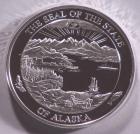2010 Alaska State Medallion - The Black Bear!


Click images to enlarge.
Please contact us for availability.
Total one ounce proof mintage: 2,476
Current List Price: $225.00
The one-ounce Official Alaska State Medallion Proof should be the first medallion in any Alaska collection. It is made of .999 fine silver mined in the State of Alaska. Each medallion is rim stamped with an individual serial number. They come encased in an air tight holder with a velvet presentation box and information card.
Black bears (Ursus americanus) are the most abundant and widely distributed of the three species of North American bears. They have been recorded in all states except Hawaii. In Alaska, black bears occur over most of the forested areas of the state. They are not found on the Seward Peninsula, on the Yukon-Kuskokwim Delta, or north of the Brooks Range. They also are absent from some of the large islands of the Gulf of Alaska, notably Kodiak, Montague, Hinchinbrook and others, and from the Alaska Peninsula beyond the area of Lake Iliamma. In Southeast Alaska, black bears occupy most islands with the exceptions of Admiralty, Baranof, Chichagof, and Kruzof. These are inhabited by brown bears. Both species occur on the southeastern mainland. Black bears are most often associated with forests, but depending on the season of the year, they may be found from sea level to alpine areas.
General description: Black bears are the smallest of the North American bears. Adult bears stand about 29 inches (.73 m) at the shoulders and measure about 60 inches (1.5 m) from nose to tail. The tail is about two inches long. Males are larger than females. An average adult male in spring weighs about 180-200 pounds (81.8 to 90.9 kg). They are considerably lighter when they emerge from winter dormancy and may be 20 percent heavier in the fall when they are fat.
The color of this bear over its entire range varies from jet black to white. A very rare white or creamy phase occurs on Kermode Island and vicinity in British Columbia. Three colors are common in Alaska. Black is the most often encountered color, but brown or cinnamon bears are often seen in Southcentral Alaska and the Southeast mainland. The rare blue (glacier) phase may be seen in the Yakutat area and has been reported in other parts of Southeast Alaska. Only the black color phase is seen on the islands of Southeast. Black bears may have a patch of white hair on the fronts of their chests.
Black bears are most easily distinguished from brown bears by their straight facial profile and their claws which are sharply curved and seldom over 1½ inches in length. Positive identification can be made by measuring the upper rear molar which is never more than 1¼ inches long in the black bear and is never less than that in a brown bear. Black bears have adequate senses of sight and hearing. They do have, however, an outstanding sense of smell.
The above information from the Alaska Department of Fish and Game
A complete Black Bear information sheet comes with each medallion.
